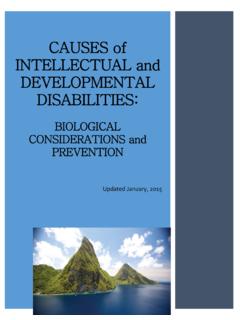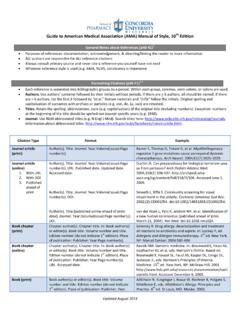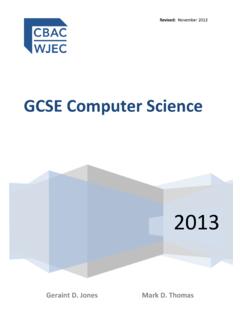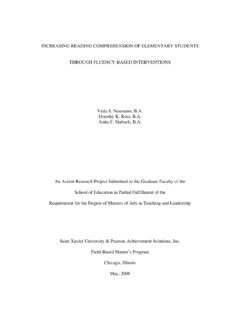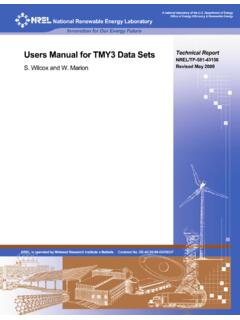Transcription of Decreasing Self-Injurious Behaviors in Children with ...
1 12/1/11 1 Decreasing Self-Injurious Behaviors IN Children WITH ASD Decreasing Self-Injurious Behaviors in Children with Autism Spectrum Disorders Susan L. McCorkle Lynchburg College 12/1/11 2 Decreasing Self-Injurious Behaviors IN Children WITH ASD Children with autism spectrum disorder (ASD) exhibit a unique collection of symptoms. These include deficits in the areas of socialization, communication, and interests and activities. A person with ASD may have a narrow range of interests that involve restricted Behaviors and the tendency to perseverate on a single topic or activity.
2 Patterns of repetitive and restrictive Behaviors , described as stereotypies, often develop that serve multiple functions for a child (Heflin & Alaimo, 2007). Self-Injurious Behaviors (SIB) are common in Children with ASD according to research by Baghdadli, Pascal, Grisi, and Aussilloux (2003). Their findings show that 50% of Children in the study experienced SIB, with at severe levels. These Behaviors can have far-reaching consequences and may restrict Children from reaching their full potential. There has been increased concern in developing successful interventions for problem Behaviors in ASD due to a rise in diagnoses of this disorder (Doughty & Doughty, 2008).
3 This paper will explore applied behavior analysis research studies that have examined interventions used in the attempt to decrease or extinguish SIB in Children with ASD. Procedural alternatives for behavioral reduction will be investigated and the results of research will be evaluated for significant influence on SIB. These include reinforcement-based strategies, extinction strategies, removal of desirable stimuli, and the presentation of aversive stimuli. The functional relationship between SIB and these alternatives for behavior reduction will be summarized. Possible interventions will be proposed and future research will be recommended.
4 Self-Injurious Behaviors The Repetitive behavior Scale-Revised (RBS-R) is based on a questionnaire that examines repetitive and restrictive Behaviors in autism. One of the six sub-scales is Self-Injurious 12/1/11 3 Decreasing Self-Injurious Behaviors IN Children WITH ASD behavior (SIB), defined as "actions that cause or have the potential to cause redness, bruising, or other injury to the body" (Lam & Aman, 2007, p. 856). Included in this sub-scale are eight Behaviors : hits with body; hits with object; pulls hair/skin; hits against surface; picks skin; bites self ; rubs/scratches; and inserts finger/object (Lam & Aman, 2007).
5 A common SIB is skin picking, defined as "the scratching or picking of healthy producing tissue damage, infection, and potential scarring" (Ladd, Luiselli, & Baker, 2009, p. 55). Repetitive Behaviors may cause significant impairments to Children with ASD that can consume their waking hours and interfere profoundly with daily life. Some Behaviors are considered socially inappropriate and may even become stigmatizing to a child. SIB in particular can have short and long term damaging effects on a child and impact the entire family. The most serious effects are tissue damage, disfigurement, health risks due to infection, and stigmatizing consequences (Humenik, Curran, Luiselli, & Child, 2008).
6 A study by Baghadadli et al. (2003) sought to identify risk factors for SIB among Children with ASD. The results showed a correlation between SIB and lower chronological age, higher degree of ASD, and lower daily living skills. These variables may be helpful in predicting the occurrence of SIB. This may also reinforce the idea that maladaptive Behaviors raise the risk of SIB in Children with ASD (Baghadadli et al., 2003). Functions of Self-Injurious Behaviors The four functions of behavior also apply to SIB. These functions are attention, escape or avoidance, access to tangible items, and self -stimulation.
7 Because SIB is a major concern for the population of Children with ASD, early intervention is beneficial to prevent more acceleration of damaging Behaviors . The first step in preventing harmful behavior is to assess its functions. It 12/1/11 4 Decreasing Self-Injurious Behaviors IN Children WITH ASD must be noted that research shows there may exist multiple functions of SIB in Children with ASD. Sometimes the functional behavior assessment does not result in a clear indication of a behavior 's function (Wachtel et al., 2009). Attention: SIBs are often maintained by the attention function.
8 Even Behaviors that do not begin as social Behaviors can develop into social attention functioning Behaviors if they are continuously being reinforced by attention (Mahatmya, Zobel, & Valdovinos, 2008). Although SIB maintained by the attention function are plentiful, these Behaviors are usually the easiest to change (Humenik, et al., 2008). Escape: Children with ASD often need accommodations in the classroom in order to be academically successful. Many maladaptive Behaviors make academic tasks difficult to master. Because of these issues, they often seek to avoid or escape from school work.
9 A study by Soares, Vannest, and Harrison (2009) found that an antecedent for SIB was the instruction from a teacher to work on academic assignments. Other things can act as antecedents that may contribute to the escape function of SIB. This can include people, events, environmental factors, or a desire for a different activity (Banda, McAfee, & Hart, 2009). If SIB provides a successful escape, the behavior is being negatively reinforced, which forms a contingency between SIB and escape consequences. Tangible items: Everyone performs Behaviors to get something. People go work in order to get a paycheck.
10 Children with ASD sometimes engage in SIB in order to gain tangibles such as food, drink, toys, or other items that serve a purpose for them. Humenik et al. (2008) showed that a girl with ASD drastically lowered her rate of SIB when given continuous access to preferred food. Another illustration of this function of behavior is shown in an ABAB designed 12/1/11 5 Decreasing Self-Injurious Behaviors IN Children WITH ASD research study involving a thirteen-year-old boy with Asperger Syndrome. When the student was given access to a computer screen with his favorite cartoon character, his rate of SIB decreased and on-task Behaviors increased (Soares et al.)

